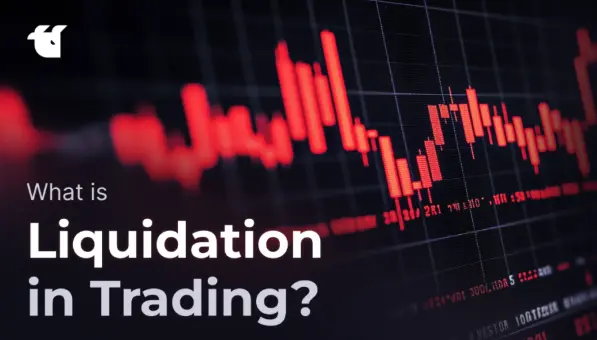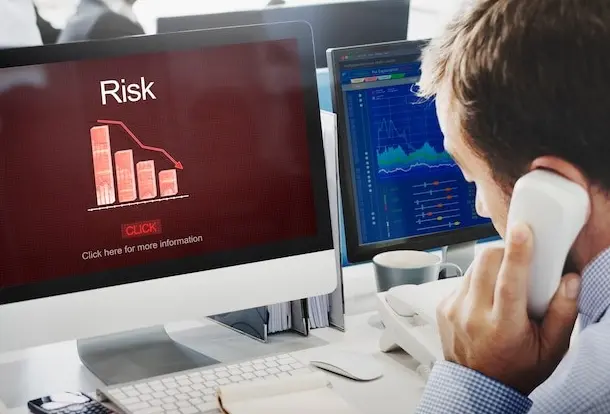Understanding Cryptocurrency Liquidation and Risk Management

Cryptocurrency Liquidation Guide: Understanding and Avoiding Forced Position Closure
Trading in cryptocurrency futures promises large fees as well as rapid profits, but it comes with impressive risks. One of the biggest risks is considered liquidation - if your position is forcibly closed due to low margin in order to recover potential losses. Understanding about liquidation can help you manage risk, avoid large losses, and make informed decisions when trading cryptocurrency futures, which is what this blog will be about.

Key findings
-
Cryptocurrency liquidation is a process initiated by the trading platform in case the trader does not fulfill the conditions according to the margin. Margin level - this is the correspondence of its cash and margin, or borrowed funds in order to use in the view together with leverage.
-
Voluntary liquidation is performed in case a trader wants to close his own deal or reallocate his portfolio. The opposite is considered a forced liquidation - a procedure in which the trader automatically closes his deal and also realizes the collateral at the liquidation price.
-
Despite the fact that liquidation can be avoided, it is done in significant numbers. Information about cryptocurrency liquidations is a valuable tool for forecasting changes in market trends and volatility, determining the exit price as well as entry, or including the recognition of market manipulation.
What is crypto liquidation?
Cryptocurrency liquidation or cryptocurrency liquidation is a common strategy where an investor sells his crypto assets for funds in order to reduce losses during a market crash. But the word “liquidation” in the cryptocurrency space means something else. Liquidation is the forced closing of an investor's position due to the loss of his initial margin. As a rule, liquidation occurs if a trader is in no way able to fulfill the conditions according to the margin for the purpose of his view together with leverage. For example, in case a trader does not have enough money in order to strengthen a disclosed operation, this can lead to liquidation.

Margin conditions will become insufficient if there is a sudden decrease in the value of the underlying asset. If this happens, the cryptocurrency exchange automatically closes the position, which leads to a loss of money to the trader. In some cases, this can even lead to a complete loss of investment for the investor.
How margin works in cryptocurrency
The act of borrowing money from a cryptocurrency exchange in order to trade the most significant number of cryptocurrencies is known as margin trading. This is able to provide the trader with more buying opportunities as well as the possibility of acquiring the most significant income.
In other words, the presence of leverage is used to create a more substantial position, compared to giving the opportunity to their funds. However, for the purpose of such traders, this is also associated with a huge risk, because the views together with leverage can be quickly liquidated, in case the market goes against them.
But margin trading is certainly not free money. In order to form a trade transaction together with leverage, the market requires the trader to bring money (fiat or cryptocurrency) as collateral, which is commonly referred to as “initial margin”.
This preliminary capital is called to secure the borrower in case of very sudden price fluctuations. The highest value opposite to the delta view is called the liquidation value. In case the bazaar value reaches this mark, the position is liquidated.
Since cryptocurrency bazaars are under-regulated and third parties do not always have jurisdiction to enforce laws, crypto exchanges choose to use the forced liquidation function rather than margin calls, if in a traditional market the broker “calls” the trader, calling for more collateral to cover the position.
When does liquidation occur?
The nature of the cryptocurrency market is volatile, and due to the popularity of margin trading, the volatility has increased. Margin trading activity is not considered original for the purpose of cryptocurrency trading, and you can use this function to trade promotions, units of money and products in Aron Groups. However, due to the high volatility of cryptocurrencies, derivatives as well as margin transactions are more popular in the cryptocurrency market.

By trading together with leverage, you are constantly exposed to the risk of liquidation, in case the bazaars in this or another level will move against you. The broker automatically eliminates your trade if you lose a certain amount of money in order to avoid further losses. Since you are trading in loaned money, the broker is allowed to do this. On the other hand, liquidation is its own family insurance in case of emergency, so that the agent does not lose even more money.
Liquidation level as risk management
The liquidation level can help manage risks and was designed to protect traders and also dealers from significant losses exceeding a certain limit. If a trader's subsidy reaches the liquidation level, all of his views are automatically covered according to the optimal easily available rate. Degrees, which have all chances to cause this impact, are depending on the broker.

Trading in monetary units as well as significant securities will often require the use of plastic leverage. In order to enter the currency market requires an initial set, known as the difference. In the presence of strong market volatility, sudden price fluctuations have all chances to lead to a rapid string of margin requirements as well as significant losses.
If the dealer makes transactions for the purpose of buyers from their names, someone acquires the risk of potential losses in case traders lose money. Another threat for the purpose of the dealer is that the trader cannot return the loan funds used for the basis of trading. The liquidation level protects the dealer as well as the trader and also ensures that the dealers have reduced the risk of potential losses.
Preventing Liquidation in Cryptocurrency
When it comes to preventing liquidations in cryptocurrency trading, two key strategies are setting stop-loss orders and maintaining the necessary margin balance. These two strategies play a major role in order to manage the risks associated with sudden market fluctuations.
Setting stop-loss orders
A stop-loss order is an in-depth prescription placed in a cryptocurrency exchange and also calculated in order to reduce the probability of being liquidated. This regulation functions as a line of mechanical execution of the order in the realization according to a specific value determined by the trader. In case the price of cryptocurrency falls down to this set degree, the stop-loss order is in effect, and also the cryptocurrency is sold. This limits the trader's losses according to the particular trade, helping to prevent liquidation.
Traders can protect their trading positions by setting stop-loss orders, which determine the price, according to which the transaction will be liquidated, in case the value of the asset reaches a specific degree. But it is important to emphasize that stop-loss orders are not considered a guarantee of liquidation, especially in volatile markets, where values can change quickly.
In order to avoid liquidation when trading cryptocurrencies, traders have all chances to reduce risk by determining the proportion of risk that they are willing to mark in the transaction. As a rule, it is recommended to risk no more than 1-3% of the amount in one transaction. By applying a stop-loss prescription to limit possible losses in case of an unsuccessful transaction, traders can productively manage their risk.
Maintaining the margin balance
Another effective strategy to prevent liquidation is to maintain a sufficient margin balance in the account. This should be especially true in futures trading, where the margin indicator should be greater than the amount of the supporting margin. If the margin indicator falls below the degree of the reference margin, the trader's position may be liquidated.
Regular checking of the margin ratio can help prevent liquidation due to a reduction in the margin rate and the degree of maintenance. By ensuring that there is always a sufficient margin balance in the account, traders have every chance to prolong their own views, including during the periods of market volatility.
Finally, eliminating liquidation in the crypto trade will require intensive risk management. By defining stop-loss orders and maintaining the necessary margin balance, traders have every chance to secure their own investments and navigate the volatile crypto market most productively. Do not forget that, despite the fact that these strategies have every chance to significantly reduce the risk of liquidation, they do not eliminate it completely. Always trade with caution and never invest more than you can afford to lose.
Factors leading to the liquidation of a futures contract
The elimination of a futures contract can trigger a number of conditions. This affects both large and short views. One of the key conditions in this case is that significant changes in the value of the underlying asset have every chance of causing large losses as well as margin conditions.
High liquidity in futures trading can make this worse. Even small cost changes can cause significant fluctuations.
Changes in interest rates have every chance of influencing the costs associated with futures positions. This can affect the profitability of the view and may also cause its liquidation. It is important to understand that plastic equipment is used in futures trading. This means that profits and losses have every chance of being increased.
Traders need to take into account market risk, changes in profitable pools, as well as their own risk tolerance. This can help reduce possible liquidation risks.
What is the liquidation price?
The liquidation price is a clear place in which the market overlaps your views along with the use of leverage. At this point, such conditions have a great impact, as well as the leverage used, the cost of the cryptocurrency, the degree of margin in order to strengthen, and besides, the balance of your immeasurable. Usually, crypto exchanges automatically calculate the liquidation price for you.
If the price of your crypto asset exceeds the set limit for the purpose of the liquidation price, the liquidation process will start. Prices in cryptocurrencies fluctuate regularly, for this reason it is very important to be one step ahead, keeping an eye on the latest value transformations.
Examples of Bitcoin Liquidation
An investor may need to eliminate their own bitcoins in order to overcome a financial emergency or close a short deal. If this is done, the depositor is obliged to sell his own bitcoins (asset) according to the current market value, regardless of whether the initial purchase price is further or higher.
But sometimes bitcoin investors have every chance and must realize their own asset at a price that is further than the market direction. This can be a liquidation value and is also dependent on the crypto exchange in which the depositor sells bitcoin.
Most importantly, you must understand that liquidation values fluctuate due to the capital of the current market. For this reason, if you want to sell your own bitcoin, it is best to study the latest liquidation values before making any final conclusion. This ensures that you get the best deal possible.
Liquidation as an analysis tool
In this case, however, the fact that this should be avoided, if possible, the liquidation of cryptocurrencies will inevitably happen, since the size of trading nowadays reaches hundreds of billions. Do you understand that this information has every chance of being used to extract meaningful data?
Information about the liquidation of cryptocurrencies has every chance to indicate changes in market sentiment, possible changes in value, as well as the overall dynamics of trading. For example, a huge number of liquidations can indicate either an excessive plastic area in the auction, which indicates a possible reversal of the auction or a correction. Monitoring liquidation data can help traders anticipate and respond to unexpected price fluctuations caused by cascading liquidations.
Liquidation data has every chance to show the degree of leverage used by traders. Large liquidation rates have every chance to indicate in this case that traders use excessive leverage, which increases the possibility of successive liquidations as well as market volatility. Traders also use them to establish the basic degrees of assistance and counteraction. For example, the accumulation of liquidations in a particular pricing degree can indicate a strong level of help or resistance, in which traders acquire margin.
In addition, unusual patterns in the liquidation information have every chance of suggesting manipulation of trading or coordinated trading activities. Traders as well as traders have every chance to apply liquidation information in order to assess the degree of risk in the market. The perception of the frequency as well as the scale of liquidations can help traders adjust their risk management strategies and position sizes accordingly.
Conclusion
When trading highly volatile assets, such as cryptocurrencies, there are a large number of pitfalls that should be avoided, as well as those that contain risks.
If a trader is in no way able to implement margin conditions for the purpose of his own unmeasured use of borrowed funds, the market will force him to eliminate his own reserves of cryptocurrency.
Despite the fact that the use of leverage in numerous variants can be a reasonable solution, according to itself, it is in no way for the purpose of the faint of heart and also in no way for the purpose of young traders. This is associated with a lot of risk and can also increase your losses.
At the same time, you will be able to reduce the risk of liquidation by controlling your margin, adjusting your leverage depending on market conditions, and using similar trading tools, as well as stop-loss orders.
FAQ
What is liquidation like in the crypto trade?
In crypto trading, liquidation is defined if the market automatically closes a trader's position due to lack of money in order to cover losses. This can help avoid further losses by closing the deal before then, as it will be too dangerous. Exchanges apply liquidation in order to protect traders and platforms from excessive risk.
Where can we see information about the liquidation of cryptocurrencies?
You will be able to get acquainted with the liquidations of cryptocurrencies in many trading platforms by watching the liquidation film or the "Liquidation" area on the exchange. This information usually shows recent liquidations, including the asset, number, cost, and root cause of the liquidation. Many third-party websites also provide real-time data on liquidations at several exchanges.
How to avoid liquidation in cryptocurrency?
To avoid liquidation in the crypto trade, set appropriate stop losses in order to limit potential losses. In addition, thoroughly control your plastic area and use it only in such a case that you can afford to lose it for yourself. Constantly monitor the market and your positions so that you can make timely adjustments if necessary.
What happens at the liquidation price?
According to the cost of liquidation, the market automatically closes the trader's position in order to avoid further losses. This happens if the trader's margin balance falls below the required supporting margin. Liquidation protects the trader from losing more than his initial capital.
Want to learn more about crypto arbitrage?
Get a subscription and access the best tool on the market for arbitrage on Spot, Futures, CEX, and DEX exchanges.







